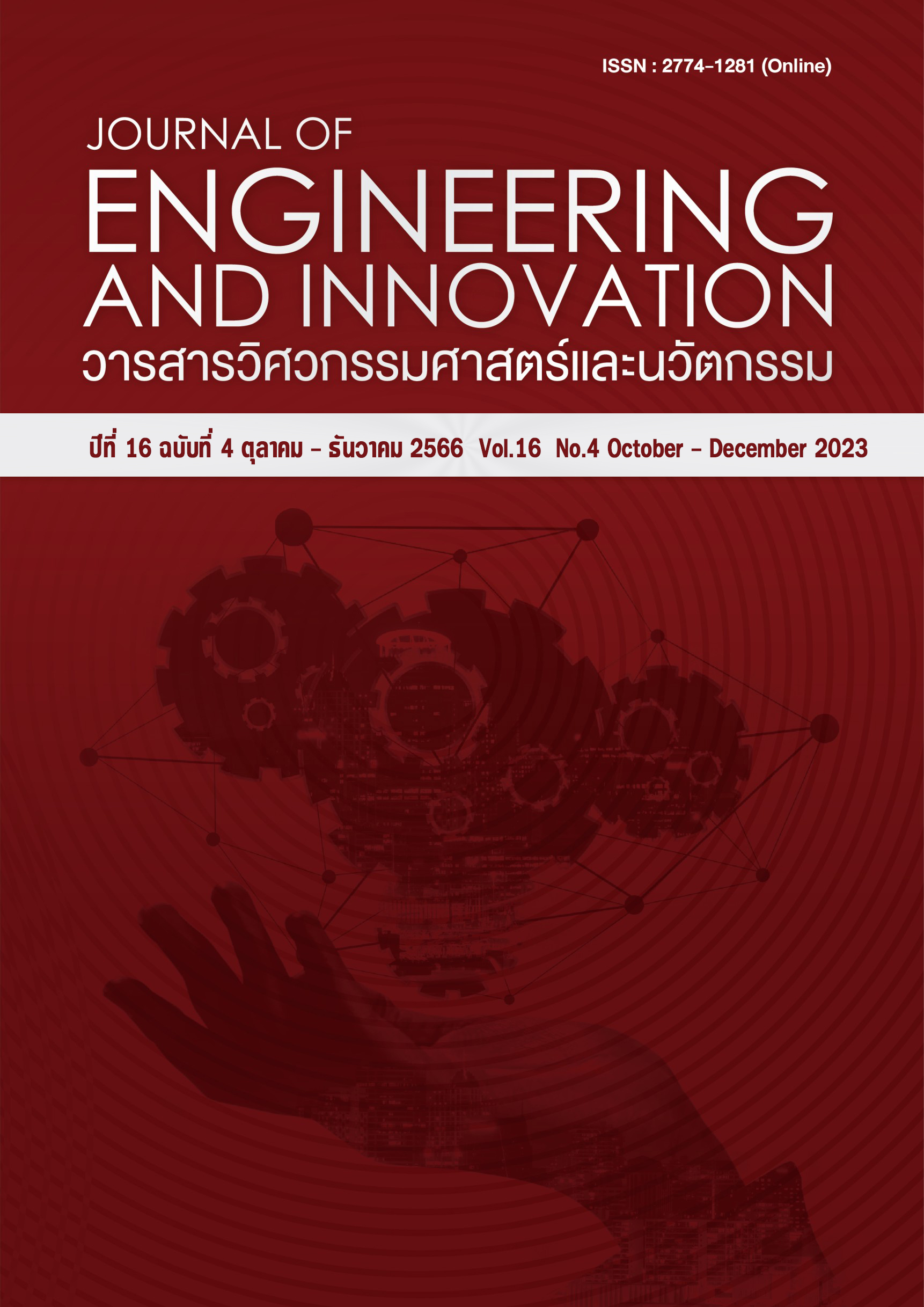The comparison of properties lightweight cellular concrete mixes banana fibers with synthetic fibers
Main Article Content
Abstract
Bananas are one of the most economically viable crops, being planted in every region and yielding annually. A section of the trunk contains high-quality fibers. but are not being used as effectively as they may be. The aim of this study was to compare the physical qualities of fibers derived from banana trunks (Banana Fibers) to those of synthetic fibers mixed with lightweight cellular concrete with a density of 1,200 kg/m3. The fiber ratio used 0.5, 0.7, and 1.0 kg/m3, the fiber length 19 mm., and the test sample size 15 X 15 X 15 cm. and 30 X 30 X 5 cm. In a laboratory for testing, it was discovered that the compressive strength of concrete block combined with banana fibers 0.5 (BF10-05) was 30.86 kg/cm2 higher than that of concrete block mixed with synthetic fibers. When mixed with banana fibers 0.5 (BF10-0.5), the water absorption rate was 4.9% lower than mixed with synthetic fibers. Similar result on thermal conductivity coefficients were observed for banana fibers 0.5 (BF10-05) and synthetic fibers. The heat retention test with an experimental box revealed that the lightweight cellular concrete with banana fibers 0.5 (BF10-05) had a lower heat retention value than the concrete block and common brick by 1.86 to 8 degrees Celsius. The scanning electron microscopy (SEM) at 2000-5000x magnification was used to examined the distribution of banana fibers in lightweight cellular concrete. From the observation of the banana fibers’s scattering and their arrangement. It shown that the banana fibers can be mixed well into the lightweight cellular concrete as effective as synthetic fibers without damaging the cavitation walls of the foam bubble structure. In result, the physical qualities of lightweight cellular concrete mixed with banana fibers perform better in numerous tests than synthetic fibers and also excess of the TIS.2601-2556 industry benchmark.
Article Details
References
Spiegel R, Meadows D. Green Building Materials: A Guide to Product Selection and Specification. New York: John Wiley & Sons, Inc.; 1999.
ชมพูนุช วีรกิตติ, ปิยะวรรณ กลิ่นศรีสุข. TCDC Material Database. เข้าถึงได้จาก: https://www.tcdc
material.com/th/article/materials-application/
[เข้าถึงเมื่อ 12 มกราคม 2565].
Cpacacademy. การใช้เส้นใยสังเคราะห์ในคอนกรีต
เข้าถึงได้จาก https://www.cpacacademy.com/
index.php?tpid=0131. [เข้าถึงเมื่อวันที่ 23 มีนาคม 2563].
สาคร ชลสาคร. ความสำคัญการปรับปรุงคุณภาพเส้นใย พืช. กรุงเทพฯ: สถาบันพัฒนาอุตสาหกรรมสิ่งทอ; 2560.
Sari KAM, Sani ARM. In: Henri A (ed.) Applications of Foamed Lightweight Concrete. MATEC Web of Conferences Engineering Technology International. France: 2017; 5.
สำนักงานมาตรฐานผลิตภัณฑ์อุตสาหกรรม กระทรวงอุตสาหกรรม. ชิ้นส่วนคอนกรีตมวลเบาแบบมีฟองอากาศ-อบไอน้ำ. มาตรฐานผลิตภัณฑ์อุตสาหกรรม 1505-2541. 2541; 115: 105ง.
สำนักงานมาตรฐานผลิตภัณฑ์อุตสาหกรรม กระทรวง อุตสาหกรรม. มาตรฐานคอนกรีตมวลเบาแบบเติมฟองอากาศ. มาตรฐานผลิตภัณฑ์อุตสาหกรรม 2601-2556. 2556; 130: 123ง. 9.
American Concrete Institute. Guide for Cellular
Concrete Above 50 pcf & for Aggregate Concrete
Above 50 pcf w/Compressive Strength Less
Than 2500 psi. ACI 523.3R-14. 2014; 1-21.
Castillo-Lara JF, Flores-Johnson EA, Valadez-, Gonzalez A, Herrera-Franco PJ, Carrillo JG, Gonzalez-Chi PI etal. Mechanical Properties of Natural Fiber Reinforced Foamed Concrete. Materials. 2020; 13: 3060.
Mugahed Amran, Rayed Alyousef, Hisham Alabduljabbar, M.H.R. Khudhair, Farzad Hejazi, Abdulaziz Alaskar etal. Performance Properties of Structural Fibred-foamed Concrete. Results England. 2020; 5:100092.
Sadia Mahzabin, Lim Jee Hock, Lim Siong Kang, Ehsan Nikbakht Jarghouyeh. Performance of Mechanical Behavior of Kenaf Fibre Reinforced Foamed Composite. AIP Conference Proceedings. 2017; (1892)1.
Jones, M.R., and McCarthy, A. Preliminary Views on The Potential of Foamed Concrete as A Structural Material. Magazine of Concrete Research .2005; (57)21-31.
วรนุช ดีละมัน, กัลทิมา เชาน์ชาญชัยกุล, กิติยศ ตั้งสัจจวงศ์.การพัฒนาและผลิตอิฐบล็อกมวลเบาโดยการผสมเส้นใยธรรมชาติ. คณะวิทยาศาสตร์และเทคโนโลยี มหาวิทยาลัยเทคโนโลยีราชมงคลพระนคร; 2559.
Bhatnagar, R., Gupta, G., and Yadav, S. A Review on Composition and Properties of Banana Fibers. International Journal of Scientific & Engineering Research, 6(Issue 5), 6.
กรกนก อักษรสม. ส่วนประกอบของกล้วย.เข้าถึงได้จากhttps://sites.google.com/site/rucakklwyhxm/swn-prakxb-khxng-klwy-1 [เข้าถึงเมื่อ 10 มีนาคม 2563]
American Society For Testing And Materials.
Standard Test Method For Tensile Properties
Of Single Textile Fibers. ASTM D3822:2001.
; 1.

